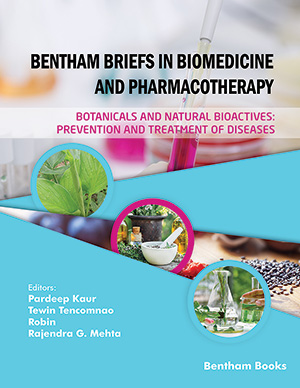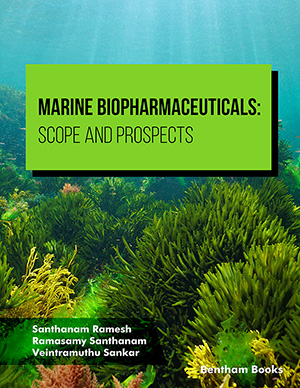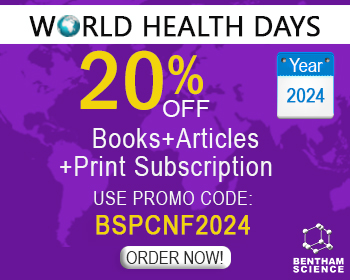Abstract
Background: Triterpenes are a large group of secondary metabolites mainly produced by plants with a variety of biological activities, including potential antitumor effects. Hepatocellular carcinoma (HCC) is a very common primary liver disease spread worldwide. The treatment can consist of surgical intervention, radiotherapy, immunotherapy and chemotherapeutic drugs. These drugs mainly include tyrosine multikinase inhibitors, although their use is limited by the underlying liver disease and displays side effects. For that reason, the utility of natural compounds such as triterpenes to treat HCC is an interesting line of research. No clinical studies are reported in humans so far.
Objective: The aim of the present work is to review the knowledge about the effects of triterpenes as a possible coadjuvant tool to treat HCC.
Results: In vitro and xenograft models have pointed out the cytotoxic and anti-proliferative effects as well as improvements in tumor growth and development of many triterpenes. In addition, they have also shown to be chemosensitizing agents when co-administered with chemotherapeutic agents. The mechanisms of action are diverse and involve the participation of mitogen-activated protein kinases, including JNK, p38 MAPK and ERK, and the survival-associated PI3K / Akt signaling pathway. However, no clinical studies are still reported in humans.
Conclusion: Triterpenes could become a future strategy to address HCC or at least improve results when administered in combination with chemotherapeutic agents.
Keywords: Hepatocellular carcinoma, cancer, natural products, antitumor, triterpenes, tyrosine multikinase inhibitors.
[http://dx.doi.org/10.1067/j.cpradiol.2015.04.004] [PMID: 25979220]
[http://dx.doi.org/10.1586/17474124.2015.1028363] [PMID: 25827821]
[http://dx.doi.org/10.1016/S0140-6736(18)30010-2] [PMID: 29307467]
[http://dx.doi.org/10.1007/s10620-019-05537-2] [PMID: 30835028]
[http://dx.doi.org/10.1002/hep.510290145] [PMID: 9862851]
[http://dx.doi.org/10.1053/j.gastro.2010.01.042] [PMID: 20114048]
[http://dx.doi.org/10.2214/AJR.13.11511] [PMID: 24951228]
[http://dx.doi.org/10.1002/hep.27160] [PMID: 24715615]
[http://dx.doi.org/10.1056/NEJMoa021423] [PMID: 12711737]
[http://dx.doi.org/10.1002/hep.27172] [PMID: 24753107]
[http://dx.doi.org/10.1016/j.amjmed.2016.12.029]] [PMID: 28109969]
[http://dx.doi.org/10.1016/j.jhep.2004.10.005] [PMID: 15664247]
[http://dx.doi.org/10.1097/CEJ.0000000000000252] [PMID: 27111112]
[http://dx.doi.org/10.4254/wjh.v3.i9.228] [PMID: 21969877]
[http://dx.doi.org/10.1517/13543784.2012.727395] [PMID: 23092199]
[http://dx.doi.org/10.1002/ijc.29210] [PMID: 25220842]
[http://dx.doi.org/10.1136/gutjnl-2013-306627] [PMID: 24531850]
[http://dx.doi.org/10.1002/hep.23691] [PMID: 20683951]
[http://dx.doi.org/10.2174/1874357901812010026] [PMID: 29541276]
[http://dx.doi.org/10.1053/j.gastro.2011.12.061 ] [PMID: 22537432]
[http://dx.doi.org/10.1038/nrc3449] [PMID: 23344543]
[http://dx.doi.org/10.1053/j.gastro.2004.09.020 ] [PMID: 15508108]
[http://dx.doi.org/10.1016/S2468-1253(16)30018-8] [PMID: 28404072]
[http://dx.doi.org/10.1016/j.bpg.2015.09.011] [PMID: 26651252]
[http://dx.doi.org/10.1159/000446680] [PMID: 27722155]
[http://dx.doi.org/10.1016/j.jfma.2015.06.003] [PMID: 26184565]
[http://dx.doi.org/10.3748/wjg.v21.i42.11984] [PMID: 26576087]
[http://dx.doi.org/10.1055/s-0035-1562943] [PMID: 26378640]
[PMID: 27482390]
[http://dx.doi.org/10.1093/annonc/mdw219] [PMID: 27226385]
[http://dx.doi.org/10.1016/j.bpg.2016.10.006] [PMID: 27938779]
[http://dx.doi.org/10.1258/096914103771773320] [PMID: 14738659]
[http://dx.doi.org/10.1111/j.1349-7006.2011.01875.x] [PMID: 21244578]
[http://dx.doi.org/10.1053/j.gastro.2009.10.031] [PMID: 19852963]
[http://dx.doi.org/10.6002/ect.tond16.l9]] [PMID: 28301996]
[http://dx.doi.org/10.1053/j.gastro.2012.09.037] [PMID: 23010303]
[http://dx.doi.org/10.1590/0102-6720201700040011] [PMID: 29340553]
[http://dx.doi.org/10.1016/j.cld.2011.03.004 ] [PMID: 21689611]
[http://dx.doi.org/10.1016/j.suronc.2016.03.002] [PMID: 27312032]
[http://dx.doi.org/10.1053/j.semdp.2016.12.011] [PMID: 28108047]
[http://dx.doi.org/10.1016/S0140-6736(03)14964-1] [PMID: 14667750]
[http://dx.doi.org/10.3390/ijms20061465] [PMID: 30909504]
[http://dx.doi.org/10.1038/onc.2011.160] [PMID: 21577205 ]
[http://dx.doi.org/10.21037/cco.2018.10.10] [PMID: 30395717]
[http://dx.doi.org/10.1080/14656566.2016.1225722] [PMID: 27598745]
[http://dx.doi.org/10.1158/1535-7163.MCT-08-0013] [PMID: 18852116]
[http://dx.doi.org/10.1007/s11523-014-0333-x] [PMID: 25213039]
[http://dx.doi.org/10.1007/s40265-018-0932-4] [PMID: 29915898]
[http://dx.doi.org/10.3748/wjg.v25.i29.3870] [PMID: 31413525]
[http://dx.doi.org/10.1007/978-3-319-91442-8_5] [PMID: 30069760]
[http://dx.doi.org/10.1007/s40265-015-0379-9] [PMID: 25792301]
[http://dx.doi.org/10.5582/ddt.2015.01054] [PMID: 26632545]
[http://dx.doi.org/10.1126/science.aar4060]] [PMID: 29567705]
[http://dx.doi.org/10.1038/cr.2016.77]] [PMID: 27325296]
[http://dx.doi.org/10.3350/cmh.2017.0004] [PMID: 28494530]
[http://dx.doi.org/10.1002/hep.29590] [PMID: 29023925]
[http://dx.doi.org/10.1007/s11101-014-9369-x] [PMID: 26213526]
[http://dx.doi.org/10.1016/j.pbi.2006.03.004] [PMID: 16581287]
[http://dx.doi.org/10.1016/10.1007 / 978-3-642-00963-1]
[http://dx.doi.org/10.1021/jf403154e] [PMID: 24279741]
[http://dx.doi.org/10.1002/bdd.530] [PMID: 17163409]
[http://dx.doi.org/10.1016/j.jpba.2005.06.034] [PMID: 16126358]
[http://dx.doi.org/10.1021/jf3023996] [PMID: 23003682]
[http://dx.doi.org/10.1021/jf302529x] [PMID: 22816768]
[http://dx.doi.org/10.2217/nnm-2016-0251] [PMID: 27809705]
[http://dx.doi.org/10.1093/pcp/pcr146] [PMID: 22039103]
[http://dx.doi.org/10.1016/j.bmcl.2019.02.020] [PMID: 30799214]
[http://dx.doi.org/10.3390/molecules25071649]] [PMID: 32260146]
[http://dx.doi.org/10.2174/0929867324666170818111933] [PMID: 28820068]
[http://dx.doi.org/10.1007/s11418-016-0976-2] [PMID: 26899240]
[http://dx.doi.org/10.3390/molecules21040460] [PMID: 27104510]
[http://dx.doi.org/10.1016/j.intimp.2016.01.027] [PMID: 26851630]
[http://dx.doi.org/10.4103/0973-1296.196308] [PMID: 28216894]
[http://dx.doi.org/10.1038/s41401-018-0047-1] [PMID: 29921885]
[http://dx.doi.org/10.3390/molecules23061338] [PMID: 29865221]
[http://dx.doi.org/10.1002/iub.2047] [PMID: 30977280]
[http://dx.doi.org/10.1016/j.bioorg.2019.103054] [PMID: 31212180]
[http://dx.doi.org/10.1080/14786419.2018.1487967] [PMID: 29923429]
[http://dx.doi.org/10.1007/s10620-019-05856-4] [PMID: 31559550]
[http://dx.doi.org/10.1016/j.ejphar.2018.10.042] [PMID: 30391347]
[http://dx.doi.org/10.1016/j.phytochem.2018.10.009] [PMID: 30352327]
[http://dx.doi.org/10.3390/ijms20194767] [PMID: 31561416]
[http://dx.doi.org/10.1016/j.phytochem.2019.112228]] [PMID: 31911265]
[http://dx.doi.org/10.1016/j.etap.2011.12.010] [PMID: 22245841]
[http://dx.doi.org/10.1016/j.canlet.2009.05.023] [PMID: 19539424]
[http://dx.doi.org/10.1002/jsfa.4678] [PMID: 22012678]
[http://dx.doi.org/10.1248/bpb.34.517] [PMID: 21467639]
[http://dx.doi.org/10.1002/hep.24000] [PMID: 20979057]
[http://dx.doi.org/10.1186/1475-2867-13-108] [PMID: 24176221]
[http://dx.doi.org/10.3892/mmr.2011.702]] [PMID: 22159471]
[http://dx.doi.org/10.1007/s13105-013-0245-8] [PMID: 23512248]
[http://dx.doi.org/10.1016/j.toxlet.2015.07.016] [PMID: 26222667]
[http://dx.doi.org/10.18632/oncotarget.12614] [PMID: 27738335]
[http://dx.doi.org/10.18632/oncotarget.21750] [PMID: 29190976]
[http://dx.doi.org/10.1038/s41419-018-0731-6] [PMID: 29880886]
[http://dx.doi.org/10.3892/ijo.31.6.1465] [PMID: 17982673]
[http://dx.doi.org/10.2147/DDDT.S110505] [PMID: 27822011]
[http://dx.doi.org/10.1016/j.biopha.2017.11.006] [PMID: 29156516]
[http://dx.doi.org/10.12659/MSM.914060] [PMID: 31152143]
[http://dx.doi.org/10.1097/CAD.0000000000000750] [PMID: 30640794]
[http://dx.doi.org/10.1155/2019/3815786]] [PMID: 31534898]
[http://dx.doi.org/10.2147/IJN.S135626] [PMID: 28652738]
[http://dx.doi.org/10.2147/IJN.S157391] [PMID: 29497292]
[http://dx.doi.org/10.1016/j.carbpol.2018.06.121] [PMID: 30093032]
[http://dx.doi.org/10.7150/jca.30865] [PMID: 31737119]
[http://dx.doi.org/10.2147/IJN.S196651] [PMID: 31239661]
[http://dx.doi.org/10.1016/j.biomaterials.2017.07.030] [PMID: 28755539]



























